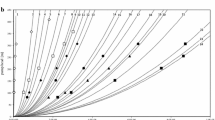Abstract
Cross-flow filtration of culture broth from Aureobasidium pullulans, which elaborates pullulan, was done with a thin channel-type module and microfiltration membranes made of different materials and with different pore sizes. Various factors affecting the results of the filtration were studied. The specific resistance of the microbial cake was found to be higher than that of bakers′ yeast, the cells of which are about the same size as an A. pullulans cell, and resistance increased with cultivation time. The flux and transmission of pullulan through the membrane decreased with cultivation time as the specific resistance increased. The flux and transmission ] of pullulan depended on the structure and pore size of the membrane and also on the pH of the broth. With a polysulphone membrane with a nominal pore size of 2.0 μm, transmission was nearly 100% with negligible leakage of cells and the flux was high when the pH of the broth was adjusted to 2.0.
Similar content being viewed by others
References
Catley BJ (1970) Pullulan, a relationship between molecular weight and fine structure. FEBS Lett 10:190–193
Catley BJ (1979) Pullulan synthesis by Aureobasidium pullulans. In: Berkeley RCW, Gooday GW, Ellwood DC (eds) Microbial polysaccharides and polysaccharases. Academic Press, London, pp 69–84
Catley BJ (1980) The extracellular polysaccharide, pullulan, produced by Aureobasidium pullulans: a relationship between elaboration rate and morphology. J Gen Microbiol 78:33–38
Heald PJ, Kristiansen B (1985) Synthesis of polysaccharide by yeast-like forms of Aureobasidium pullulans. Biotechnol 27:1516–1519
Jeanes A (1977) Dextrans and pullulans: industrially significant α-d-glucans. Am Chem Soc Symp 45:284–297
LeDuy A, Choplin L, Zajic JE, Luong JHT (1988) Pullulan. In: Mark HF, Bikales NM, Overberger CG, Menges G (eds) Encyclopedia of polymer science and engineering, 2nd edn. Wiley, New York, pp 650–660
Margaritis A, Pace GW (1985) Microbial polysaccharides. In: Moo-Young M, Cooney CL, Humphrey AE (eds) Comprehensive biotechnology vol. 2. Pergamon Press, Oxford, pp 1005–1044
Nakanishi K, Tadokoro T, Matsuno R (1987) On the specific resistance of cakes of microorganisms. Chem Eng Commun 62:187–201
Scott TA Jr, Melvin EH (1953) Determination of dextran with anthrone. Anal Chem 25:1656–1661
Ueda S, Fujita K, Komatsu K, Nakashima Z (1963) Polysaccharide produced by the genus Pulularia. Appl Microbiol 11:211–215
Wynne ES, Goth CL (1966) A proposed revision of the genus Pulularia. J Gen Microbiol 14:512–519
Yuen S (1974) Pullulan and its application. Process Biochem 9:7–9, 22
Author information
Authors and Affiliations
Additional information
On leave from Hayashibara Co., Ltd., Amase-minamimachi, Okayama 700 Japan
Correspondence to: K. Nakanishi
Rights and permissions
About this article
Cite this article
Yamasaki, H., Lee, MS., Tanaka, T. et al. Characteristics of cross-flow filtration of pullulan broth. Appl Microbiol Biotechnol 39, 26–30 (1993). https://doi.org/10.1007/BF00166843
Received:
Accepted:
Issue Date:
DOI: https://doi.org/10.1007/BF00166843



